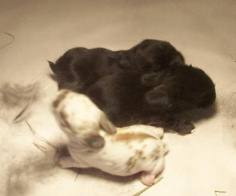Moving Kits from One Doe’s Litter to Another’s Nest
 When I have small litters, I often combine them so that a fewer number of does are occupied with nursing. The does that are freed up can then get back into show condition (a relatively small percentage of does can do that) or, more likely, can be rebred in a day or two. Sometimes, I foster babies to even out litters. I think that between three and five babies is a good number of kits for a nestbox.
When I have small litters, I often combine them so that a fewer number of does are occupied with nursing. The does that are freed up can then get back into show condition (a relatively small percentage of does can do that) or, more likely, can be rebred in a day or two. Sometimes, I foster babies to even out litters. I think that between three and five babies is a good number of kits for a nestbox.
A singleton will often chill and die if left alone. If it survives because of very hot weather or the use of a nest box warmer, then it is at risk of being overfed, which can cause splayed legs. A couple of babies from a larger litter are added to the singleton’s nest or the singleton is added to a nest that has room for one more.
I have had to foster kits due to problems with the doe such as illness. I often sell my favorite does when they are bred with the caveat that they can leave the barn when the babies are born and fostered. I find it easier to give her up if I know I’m getting one last litter!
I have fostered kits up to the age of 19 days (in the case where my doe was dying). In that case, I removed the doe from the cage and added the new kits. I let them stay together for a couple of hours before returning the doe to the cage. She seemed to be very suspicious that something had changed, but after sniffing around awhile, she jumped into the box and fed the whole combined litter.
 Normally when I foster kits, I just place the newborn into the box without any special preparation. If I have a doe I’m not familiar with or one that seems to be easily upset, I place a small dot of Vicks VapoRub above her nose. Other breeders use a drop of vanilla extract. I don’t know if it really helps, but it has never hurt.
Normally when I foster kits, I just place the newborn into the box without any special preparation. If I have a doe I’m not familiar with or one that seems to be easily upset, I place a small dot of Vicks VapoRub above her nose. Other breeders use a drop of vanilla extract. I don’t know if it really helps, but it has never hurt.
If the colors of the kits can be confused, I mark the side of the ear with a green or purple permanent marker. Then I remark the ear every day or two. I use to use a black marker, then a faded dark mark can be confused with natural coloring. A green mark, no matter how faint, is proof positive.
One last thought about fostering concerns the doe. I try to allow first-time moms to nurse their litters to help them add experience to their instinctual urgings. Besides sale bunnies, I try to free up older does that need to stay in production to protect their fertility, does that can get back into show condition and complete, and does who are producing my top bunnies. In addition to first-time moms, I try to foster kits to dams who have dead litters. I believe that it helps them to produce live kits sooner. It may be just a belief, but it seems to help.
